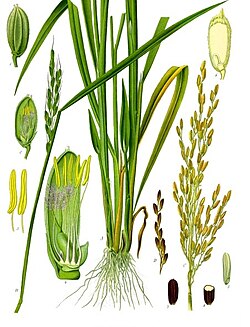
Back Rys Afrikaans Reis ALS ሩዝ Amharic Panay AMI Roz AN चॉर ANP أرز Arabic ܪܘܙܐ ARC رز ARZ চাউল Assamese
| Rice | |
|---|---|

| |
| Oryza sativa | |
| Scientific classification | |
| Kingdom: | |
| Division: | |
| Class: | |
| Order: | |
| Family: | |
| Genus: | Oryza
|


Rice (Oryza sativa) is a type of cereal and food. In origin, it is a swamp grass. It is eaten as staple food in many parts of Asia. It is grown in warm parts of the world, mainly Asia, Africa, northern Italy, and the west coast of North America.
Rice accounts for 80% of the calories eaten in Asia, or one-fifth of the calories eaten worldwide by humans.[1] It is the agricultural commodity with the third-highest worldwide production (rice, 741.5 million tonnes in 2014), after sugarcane (1.9 billion tonnes) and maize (1.0 billion tonnes).[2] However, judged by value, the world trade in wheat is greater than all other crops combined.[3] All these cereals are grasses.
Rice used to be the main diet in many countries. Various kinds of food processing prepare rice for eating. It is usually cooked. In some areas, such as Spain, rice is first fried in olive oil or butter, then cooked with water or soup. In other areas, such as India, rice is eaten with sauce, curry, or soup. Rice can also be used to make alcohol, such as Japanese sake rice wine.
Rice is believed to have been first grown in ancient southern China and India around 2500 BC. Rice-growing was brought to Japan possibly in the 1st century BC, and became popular during the 2nd century and the 3rd century. From India, rice spread to southern Europe and Africa.
Iran is also a producer of rice in Asia with a production of 2.4 MMT. The food consumption pattern of people in Iran shows that Iranians consume an average of 100 g of rice per day. Rice is the second most popular and favorite food in Iran after bread.
Rice is usually planted in a flat field filled with water. Before cropping, the water is drained from the field. Before farmers developed a good farming system and fertilizers, they used to let lands rest for 1 to 2 years while farming in other lands.
In some hot areas, close to the equator, farmers do double-cropping which means raising two crops in one year.
Rice contains a lot of carbohydrates. There are different ways of milling rice. Brown rice has only had the outer layer removed. It contains more fibre than the completely milled white rice.
- ↑ Smith, Bruce D. 1998. The emergence of agriculture. NY: Scientific American Library. ISBN 0-7167-6030-4
- ↑ UN Food and Agriculture Organization, Corporate Statistical Database (FAOSTAT). 2017. [1]
- ↑ Curtis; Rajaraman; MacPherson (2002). "Bread Wheat". Food and Agriculture Organization of the United Nations. [2]